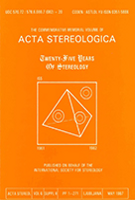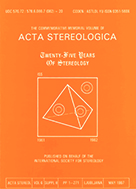- Portada
- Volume 11 (1992)
- Number 1 - Quantitative histopathology - Aug. 1992
- S-phase fraction analysis in DNA static cytometry in breast cancer. Comparison with proliferating cell nuclear antigen (PCNA) immunostaining
Vista(s): 519 (1 ULiège)
Descargar(s): 83 (1 ULiège)
S-phase fraction analysis in DNA static cytometry in breast cancer. Comparison with proliferating cell nuclear antigen (PCNA) immunostaining

Abstract
The aim of our study was to evaluate human breast carcinomas for cell cycle data in cytologic material analyzed with DNA static cytometry (DNA SC) and to compare the results with the presence and distribution of PCNA immunostaining on tissue sections. The same cases were also investigated with a flow cytometric technique (DNA FC).
In three out of the six cases investigated, the static and flow cytometric analyses showed a histogram with a single G0-G1 peak containing the majority of the nuclei, accompanied by elements in the S and G2 compartments. As for the cell cycle data, good correspondence between the two techniques was observed, the closest being for the percentage of nuclei in S phase. The proportion of PCNA immunostained nuclei was high in all three cases. Those staining positively were subdivided into either intensely-stained nuclei with either a homogeneous or granular pattern, or lightly-stained nuclei with a granular pattern. The proportion of nuclei with the former appearance was similar to the percentage of S phase nuclei. In the remaining three cases, the static and flow cytometric analyses produced a histogram with two peaks, the first diploid and the second aneuploid, which were similar with both techniques. In these cases the cell cycle analysis for both peaks was performed only on the cytologic material using the two-cell-cycle option of the software. In the two cases where the two peaks were separated, information about the compartments was obtained and the average S-phase fraction was comparable to the proportion of intensely-stained nuclei with either homogeneous or granular pattern in the PCNA immunostaining. In case 5, the two peaks were closely positioned. Therefore, the cell cycle data were obtained only for the aneuploid population whose average S-phase fraction in DNA SC was lower than the percentage of intensely PCNA immunostained nuclei.
In conclusion, our study showed that cell cycle analysis is feasible in Feulgen-stained cytologic material in cases with either a single-cell population or with two distinct populations. The proportion of the most intensely-stained nuclei with the anti-PCNA antibody is generally comparable to that of the S phase nuclei.






